
Tekla Structural Designer 2020 SP5 Update | 53.9 mb
Trimble introduced the update (SP5) of its Tekla Structural Designer 2020 software, is software that gives engineers the power to analyze and design buildings efficiently and profitably. This update includes a number of enhancements and issue resolutions.
Issues with Associated Bulletins
[TSD-8103] - Piled Mat Foundation Slabs - RSA Seismic Design - For the seismic combinations Static+RSA & Static-RSA and where tension occurred in these, piles were not checked for tension capacity in some circumstances. This could produce an unconservative result where an unchecked tension capacity would govern the pile design.
- This issue is fixed in this release. In addition the pile design report now includes the pile capacity check for all selected RSA combinations
General & Modeling
A number of additional fixes which are not detailed explicitly here are also made to improve general performance and stability. An example of this is given directly below:
- [TSD-7940] - Report Generation - Analysis Elements with no material (e.g. Linear and non-linear axial/torsional springs) no longer prevent the generation of reports that contain the following report chapters: Material Listing, Analysis>Elements, Analysis>Element-Member, or Analysis>Element Properties.
[TSD-7773] - Selection Properties Grid - the organisation of the property grid dropdown list of currently selected entities has been changed as shown in the picture below:
- As the range of objects available in the program has increased, a simple list organised alphabetically has become unwieldy in some circumstances, so it is now organised by object, material and fabrication types (in a similar manner to the Entities to be deleted filter dialog).
- We believe that all users will appreciate this more clear and logical organisation, however we do acknowledge there may be an initial sense of unfamiliarity for longer-term users.
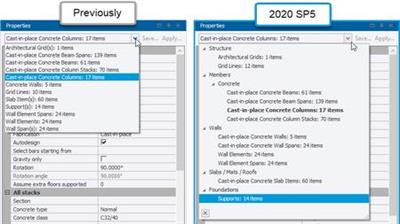
[TSD-6135] - Export to Excel - the send to Excel export option (for Model and Results and Design tabular data, Wind Tunnel Data and Reports) no longer relies on Microsoft Excel being installed on your computer; if it is not installed an Excel (*.xlsx) file is still created. In addition, the time taken to export large files has been significantly reduced.
- Note that a further difference to previous releases behaviour is that an Excel file (*.xlsx file) is now created in your Windows user Temp directory (C:\Users\user_name\AppData\Local\Temp where "user_name" is your Windows user name). You can then elect to save the file to another name/ location as you require
[TSD-7691] - Slabs - Steel & Timber Deck & General - slabs of any General material (e.g Aluminium or any user-defined material) can now be created. In addition, on the Model ribbon the Steel and Timber Deck types are now combined under one common tab 'General' with the inclusion of the new 'General' deck option, as shown in the picture below. General material slabs are created in the same manner as other slabs (slab on beams) and have the same one and two-way decomposition, properties and loading options as the existing deck types.

Other aspects of this enhancement are:
- Timber decks can now be set to two-way decomposition.
- The Imposed Load Reduction % option is now available for all these General slab types.
- The material of Steel and Timber (and the new general type) decks can now be selected from the material database where previously it was only user-defined. As shown in the picture below, there is a new property for selection of the steel/timber/general material grade. There is also a new "Override material properties" checkbox to allow user-defined properties (when enabled the grade selection option is removed). This option is off by default for new slabs.
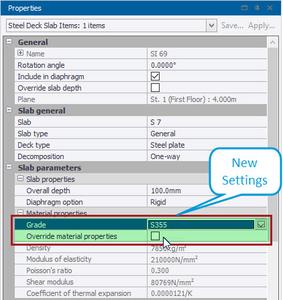
Note the following:
- Existing models - in those with Steel or Timber deck slabs, the "Override material properties" checkbox for these will be enabled and thus the existing properties retained. The user can then decide if they wish to edit this and instead apply a material grade.
- Timber grades cannot currently be directly set for Timber decks because the Poisson's ratio is generally invalid for isotropic elastic analysis (of 2D elements), for which it must be > 0 and
- Two-way General material slabs can be meshed in 3D analysis and graphical analysis 2D results obtained just as for two-way concrete slabs (including result lines and strips), however there is no design for them. New Analysis modification factors are also added for them (default value 1.0).
- BIM Integration - General slabs can be imported/exported as per the current functionality of Structural BIM Import/Export. Note that for optimum integration (in relation to material mapping) it is recommended to use database materials for General slabs rather than applying 'override' properties.
- General slabs are also added to the Scene Content settings, and the Review View > Tabular data for material listing (and the associated report item settings) is now separated and enhanced for general material slabs.
[TSD-7590] - Structural Walls - different types of wall fabrication - e.g. Cast-in-place and Precast - are now separated in the property grid as shown below to allow easier editing of similar wall types in complex models. These different wall types are also now separated when reviewing Material list data, both in the tabular data view - via new Fabrication filter buttons as shown in the picture below - and in the settings of the associated Reports item.
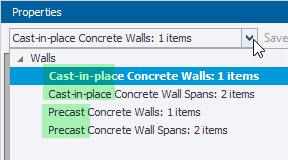

[TSD-3038] - Copy/ Move Beams and Construction Levels - copying or moving a beam that is created at an existing construction level to a location which is NOT at a level - e.g. between floors - no longer creates a new construction level at this location height. This is important since it has implications for the creation of column stacks and hence design. Note the following:
- It is not necessary to have a construction level in order to place beams (or cladding rails etc) at a level - e.g. to span between columns between floors. Beams can be connected to columns at any point within their length.
- Where a beam connects to a column at a construction level, the column will be divided into stacks above/below this level. This has implications for design and is an engineering decision since the stack lengths are used to determine effective lengths and in sway/drift checks.
Performance
[TSD-7221] - Graphics - the graphics driver settings in Home > Settings > Scene > Graphics are updated and adjusted as shown in the picture below.

Note the following regarding this change:
- The "DirectX (old)" option was based on DirectX 9. This is no longer supported by the latest version of the graphics engine and has been removed from the list.
- Existing installations set to "DirectX (old)" by default will see this setting automatically updated to the "Auto" option. This setting allows HOOPS (the 3rd party graphics engine used by Structural Designer) to pick the optimum driver and is now the default for new installations. We do recommend checking your current Graphics Driver setting and setting it to the Auto option if necessary.
- To check your graphics adapter's compatibility visit the HOOPS developer website for HOOPS 25.xx, DirectX and OpenGL requirements.
- [TSD-7523 & 7545] - Graphical Issues - it is expected that this update will render the program graphics more reliable in general and potentially resolve some more rare graphics issues such as gridlines becoming intermittently invisible and associated crashes.
[TSD-4843] - Analysis Process - the handling of analysis warnings/errors during analysis is improved to limit the number of these stored and listed with results. Previously, for larger models containing analysis issues (such as instabilities due to mechanisms), this process could occupy significant analysis time/ resources and prevent saving after analysis. The improvement resolves the latter issue and can reduce analysis times for such models from several minutes to a matter of seconds, enabling much more rapid troubleshooting and resolution of analysis problems.
Interoperability
[TSD-8064] - Carbon Calculation - Export data to "One Click LCA" - the carbon impact of construction is under ever greater scrutiny and engineers are often now required to assess the Building Carbon Footprint of their projects. An exciting and powerful new feature is added in this release to assist with this. The engineer can now easily create a report of the project materials data to quickly determine its embodied carbon using One Click LCA. Note that a subscription to the One Click LCA App is required in order to use this (see the website One Click LCA for more details). As shown in the picture below, a new button for this is added to the BIM Integration ribbon. This automatically compiles a very compact summary of materials in the project which can then either be uploaded to One Click LCA or viewed directly.

- When the One Click LCA export button is selected, the Report options dialog is displayed as shown below. To view the report directly, click the "Show report" option - the report is written to an Excel (*.xlsx) file, which will open automatically provided you have an installed application associated with this file type. This data file can then be shared with any other parties. Alternatively you can send the data directly to One Click LCA cloud by entering your sign-in credentials (your One Click LCA credentials not those of your Trimble Identity) and selecting Log in.

- In One Click LCA you can then create or choose a project for your data, consider groupings and review/ apply mapping. An example of how this looks is shown below.
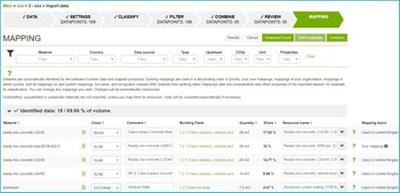
[TSD-6321] - Export to CXL (Structural BIM) and IFC - Levels - to give greater control over the export of levels to BIM Applications (both Tekla Structures and Revit via CXL file) and IFC, a new setting "Include in Export" is added to Level properties as shown in the picture below. The setting option determines whether the level is exported as follows:
- Floor Only - included in export only if defined as a floor (the "Floor" option is enabled in Level Properties/ Construction Levels)
- Yes - always included in export
- No - never included in export.

[TSD-6970] - Structural BIM Import - Foundations - Wall Strip Bases (Footings) - the import of valid strip footings via the Structural BIM import process is improved to cater for cases where the footing does not extend to one or both ends of the wall. Previously, such footings would be imported automatically as foundation mats. New tolerance has been added such that this will only occur when the overlap between the wall and the footing is smaller than 20% of the wall length on either side, effectively allowing for strip footings up to 40% shorter than the wall length.
[TSD-6615] - BIM Integration - Column Splices - an issue is fixed which caused an error when importing a CXL file to update an existing Structural Designer model when column splice locations were altered in the BIM application (e.g. Revit).
Analysis & Results
[TSD-7634] - Trusses - Releases - for any truss bottom chord, the axial load release option can now be enabled at both ends simultaneously, where previously only one end was allowed. This allows the easy modeling of "slotted" type connections - which allow some amount of horizontal movement and hence do not transfer axial load - which are commonly used where parallel chord truss bottom chords connect to a column.
[TSD-6597] - Solver Model - Rigid Offsets - a more rare issue causing rigid offsets not to be updated correctly in the solver model following some model edits is fixed in this release. For existing models with this issue the solver model will be rebuilt and any existing analysis results cleared when opened in this release - results can then be re-established by running analysis or design.
Design
[TSD-7930] - Design Groups - Columns - In previous releases, the grouping criteria for steel, timber and cold formed columns were not as stringent as those for concrete columns in that there was no requirement for all group members to share the same section size. This significantly hindered the workflow when attempting to design using groups. This is addressed In this release by the introduction of a new grouping criterion for timber and steel columns requiring section sizes to be consistent within each group. Note the following:
- For timber design using Tekla Tedds, this removes the previous restriction that made it the users responsibility to ensure all members of column groups were the same size.
- When a model from a previous version is opened in 2020 SP5, the new grouping criterion is automatically applied. Any existing timber or steel column groups containing mixed section sizes have the inconsistent members removed, (either to another suitable existing group, or if none exists a new group is automatically created).
[TSD-7606 & 7644] - Precast Concrete Columns - Eccentricity Moments and Load Patterning - eccentricity moments are now automatically calculated and considered in the determination of the moments for the design of precast columns using Tekla Tedds. Additionally, eccentricity patterning of live loads can also now be considered for determination of both axial forces and design moments for precast columns in the same manner as that introduced for Steel columns in the 2020 SP4 release.
- The following new settings are added for this feature:
- Column properties - new settings for Eccentricities for each face and level at which beams connect to the column.

- Global and Model setting - new setting under Loading > General to enable patterning "Use patterning of eccentricity moments for precast columns" (on by default for new and existing models).
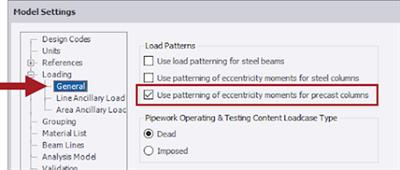
Note the following:
- Analysis of eccentricity moments applies to all Head Codes, however design using Tekla Tedds is only available currently for the Eurocode.
- Eccentricity moments are calculated only for connected beams that are pinned. They can be viewed in the Load Analysis view in the same manner as for steel columns.
- The minimum axial force considered by design using Tekla Tedds is capped by the Axial force ignorable limit if it is less than this (default 0.5 kN).
- A warning for tension is issued if the axial force in a lower stack is below 0.0.
[TSD-3801] - Isolated Foundations - Pad/Strip Footings - All Head Codes - the auto-design process for Pad/Strip Footings is improved to increase the depth to attempt to pass the uplift condition where previously only the footing size (plan dimensions) was increased. Where uplift governs this should produce a passing solution in more cases, or a more logical and useful failure where the design size constraints (Design > Settings > Concrete > Foundations > Isolated Foundations > Foundation size) are too restrictive for a passing solution to be found.
- Note that the user can reduce the maximum side length/ strip width constraint to promote solutions of smaller plan dimension/ deeper footings.
[TSD-7606] - Slab Design - Column Drops - the design of slab drops and punching shear checks draw some of their design data from the parent slab they are assigned to. Although these entities can only be assigned to one parent slab, in previous releases they would be allowed to overlay different parent slabs and this could sometimes create issues such as incorrect geometry, unexpected design data or invalid objects. This is addressed in this release as follows:
- Both slab drops and punching shear checks are restricted to the parent slab they are assigned to, on the assumption that connected slab items of identical type are expected to have the same slab parent.
- For existing models with more unusual situations this could result in changes in slab drop and punching shear check geometry or these objects becoming invalid. Hence for existing models opened in this release, you are advised to review these for any such occurrences. Where they do occur you can consider alterations to the slab items or parent slabs to ensure drops/ punching checks overlay them as expected.
- Note that for invalid slab drops, their properties can be exposed from Model Geometry > Slab Items in the Status tree in order to change their parent slab.
[TSD-8109] - Concrete Beam Design - Links (Stirrups) - improvements are made to the creation of top closures for open links. Only one top closer is now created at each position. When there are multiple links at the position, if there is no "outer link" then the top closer will still link the outer legs. Note that this change could result in a (very small) reduction in quantity of reinforcement.
[TSD-8049] - Review View - Sway/ Drift tabular data - a problem introduced in the previous 2020 SP4 release preventing the sorting of the Sway/ Drift tables via the column headers (e.g. by lambda/alpha/ drift ratio value) is fixed in this release.
Reports and Drawings
Reports:
[TSD-7728] - Report Creation and Send to Excel - when a report is generated, or report data is sent to Excel, the status of existing analysis and design data is checked and the following warning issued if this is out of date - "Some results are out of date. Do you want to continue?". The warning could often be issued erroneously when it did not relate to the data being reported/ exported. Improvements are made in this release to reduce the occurrence of such unnecessary warnings and the warning message is enhanced to state which results (of Analysis, Concrete Design or Steel Design) are out of date.
Drawings:
[TSD-7601] - General Arrangement - Cold Formed Trusses - new DXF layers for cold formed trusses have been added so that they are now displayed in General Arrangement Drawings where previously they were omitted. The default drawing settings have been updated with these in the settings sets. Note that these can be loaded into existing models via Draw > Settings > Load.
This release will upgrade your Tekla Structural Designer installation to version number 20.0.5.56 and should be installed to ensure optimum function of the program. It includes a number of enhancements and issue resolutions as detailed below.

Tekla Structural Designer delivers powerful features for optimizing concrete and steel design, including the ability to quickly compare alternative design schemes, efficiently manage changes and collaborate seamlessly. Regardless of project size or complexity, Tekla Structural Designer's fully automated, productivity-enhancing capabilities enable engineering firms to improve operations, successfully bid more projects and enhance client service.
Tekla Structural Designer 2020 structural analysis and design software introduces data-driven design with a new direct link between Tekla Structural Designer and algorithmic modeling plugin Grasshopper, enabling quick and easy exploration of different early-stage design alternatives.
Modeling has never been easier with Tekla Structural Designer. From modeling in 3D or 2D views, to duplicating levels and several built-in tools, Tekla Structural Designer allows you to quickly model any structure. Watch this short video to learn more about some of the tools that will speed up your modeling time.
Tekla software solutions for advanced BIM and structural engineering are produced by Trimble. Trimble's construction offering ranges from total stations to advanced software, giving the industry tools to transform planning, design, construction and operation of buildings. Tekla software is at the heart of the design and construction workflow, building on the free flow of information, constructible models and collaboration.
Product: Tekla Structural Designer
Version: 2020 SP5 (build 20.0.5.56 ) Update
Supported Architectures: x64
Website Home Page : www.tekla.com
Language: english
System Requirements: PC *
Software Prerequisites: Tekla Structural Designer 2020 and above
Size: 53.9 mb
Tekla Structural Designer 2020 hardware recommendations.
System requirements for effective operation
CPU: Multi core Intel i5 Series or above, Xeon or AMD equivalent
- Highest affordable performance recommended.
Memory: 16GB (32GB or more recommended)
- Memory requirements are highly dependent on model content.
OS: 64-bit Microsoft Windows 8.1 / 10
- Operating systems must be running the latest service packs / updates.
Graphics: 1600 x 900 resolution (1920 x 1080 or higher recommended)
- 1GB or higher of dedicated RAM.
- Utilizes HOOPS Visualize, a third party graphics engine available from Tech Soft 3D. To check your adapter's compatibility visit the HOOPS developer website for HOOPS 20.x, DirectX and OpenGL requirements.
Disk space: 1GB or more of free space for installation
- Operational disk space requirements are highly dependent on model content.
Internet connection: Required for access to Online Services and some documentation.
License Service:
- Tekla Structural License Service 3.00 including Sentinel RMS 9.5
License Server: The latest version of the Tekla Structural Licence Service, at time of release, is shipped and installed with the software. If you have chosen to have a separate licence server, it is always our recommendation that you also run the latest version of the Tekla Structural License Service on it to ensure compatibility. Please see System Requirements for specific version details.
Test environments
The application is tested and supported on the following business versions of Microsoft Windows with the latest updates applied:
- Windows 10 64-bit
- Windows 8.1 64-bit
Buy Premium From My Links To Get Resumable Support,Max Speed & Support Me

https://uploadgig.com/file/download/468B70601129C416/skgmm.Tekla.Structural.Designer.2020.SP5.Update.rar

https://rapidgator.net/file/a587ed67718c402f00e5e4fe649a920b/skgmm.Tekla.Structural.Designer.2020.SP5.Update.rar.html

http://freshwap.cc/view/C3581EFAF7DE9CE/skgmm.Tekla.Structural.Designer.2020.SP5.Update.rar
 Views: 82
Views: 82  Comments (0)
Comments (0)
free Tekla Structural Designer 2020 SP5 Update, Downloads Tekla Structural Designer 2020 SP5 Update, RapidShare Tekla Structural Designer 2020 SP5 Update, Megaupload Tekla Structural Designer 2020 SP5 Update, Mediafire Tekla Structural Designer 2020 SP5 Update, DepositFiles Tekla Structural Designer 2020 SP5 Update, HotFile Tekla Structural Designer 2020 SP5 Update, Uploading Tekla Structural Designer 2020 SP5 Update, Easy-Share Tekla Structural Designer 2020 SP5 Update, FileFactory Tekla Structural Designer 2020 SP5 Update, Vip-File Tekla Structural Designer 2020 SP5 Update, Shared Tekla Structural Designer 2020 SP5 Update, Please feel free to post your Tekla Structural Designer 2020 SP5 Update Download, Movie, Game, Software, Mp3, video, subtitle, sample, torrent, NFO, Crack, uploaded, putlocker, Rapidgator, mediafire, Netload, Zippyshare, Extabit, 4shared, Serial, keygen, Watch online, requirements or whatever-related comments here.
Related Downloads :
{related-news}

